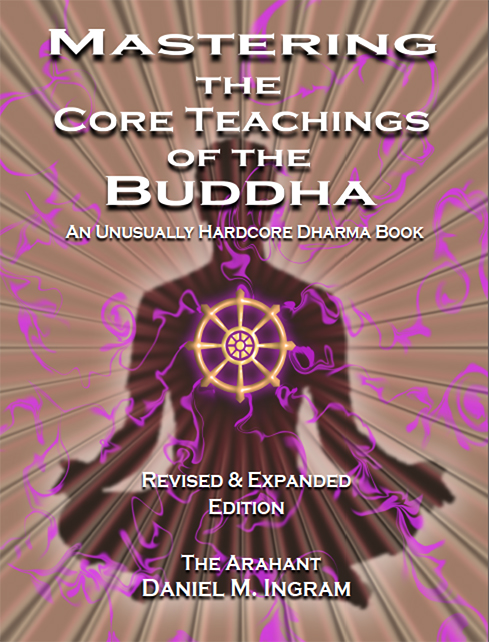65. How to Cultivate the Powers
← 64. Ethics and the Powers | 66. Made Pliant and Malleable →
Now that I have laid out even more various obligatory and useful warnings and disclaimers, here’s how to try to achieve the powers. If we want to cultivate the powers and greatly increase the chances of them occurring with some degree of reliability and repeatability, we must generally attain very “hard” jhanic states with the specific intention to attain these experiences, though they can and often do arise spontaneously. The Visuddhimagga in chapters four, five, twelve, and thirteen, and the Vimuttimagga (less encyclopedic but much more readable) in chapter eight, section one, and in chapter eleven, spell out in great depth and detail how to attain siddhis. While their instructions are so straightforward that you may miss their profundity, just follow them as stated and see what happens. You could also check out Bhante Gunaratana’s excellent work, The Path of Serenity and Insight. Simply follow the directions and explore, as these instructions are as accurate as they come.
While magickal or mythical thinking is sometimes very unhelpful on the spiritual path, we must admit that it is the only kind of thinking that can make much sense of these sorts of experiences. However, know when and how to turn it on or off. If you are doing Jungian psychotherapy, shamanic path-working, working up the Tree of Life, or through the tarot, or any similar work, think as magickally and mythically as you wish. It might be very helpful. If you are trying to do most other things, don’t! Still, the more you get your concentration strong and play with the powers, the less strange the paradigms and stories of the old texts become.
While Theravada Buddhism clearly states how to obtain the siddhis, it does not say much that is explicit, well-organized, or practical about how to use them, or about their benefits and dangers. Tantra and many other traditions (such as some of the pre-Buddhist shamanic traditions) do a much better job of dealing with these, and so I am trying to bring some of that same level of explicit advice to this end of the world of meditation. We might also check out the later writings of Carlos Castaneda when he was not so fascinated with hallucinogens, such as The Art of Dreaming, or go to an ashram or monastery that focuses on the magickal aspects of spiritual training, such as Pa Auk Sayadaw’s tradition, or check out traditions such as ceremonial magick, Wicca, Thelema, the Golden Dawn, and the Astrum Argenteum.
As you probably already noticed, I use magick with a k due to being personally influenced by these and related traditions, as they advocate making a distinction between “show magic” (illusions based on mechanical mechanisms, props, distraction of attention, and sleight of hand) and the territory of the powers, aka “magick”. Donald Michael Kraig’s Modern Magick is a classic on the subject, as are the works of Aleister Crowley. Opinions on Crowley vary widely, but buried in the frustrating works of that complex person is gold that is hard to find elsewhere. Despite all of Crowley’s obvious quirks, personality disorders, and serious failings, I have a deep appreciation for many aspects of his work and the depths of his dedication to making meditation and magick accessible. You might check out Magick without Tears for the better end of his works. Still, aspects of that tradition can sometimes lack a solid grounding in ethics and compassion.
Back to the practice: I really like kasina practices for getting into hard jhanas as they give you such nice, immediate, basically foolproof feedback on exactly how you are doing. Start by choosing an external object such as a colored disk, candle flame, or something similarly neutral. If you are training in a tradition that advocates specific, symbolic, positive images, use one of those as is appropriate to the instructions of your lineage. Once you close your eyes and focus on the after-image, what happens with that image will be directly related to your strength of concentration. When your concentration is strong, the images are clear and bright and take over your world, and when it is weak, well, that doesn’t happen in the same way.
As mentioned a bit later, the fire kasina was the method I used initially to get into the territory where the powers were very easily available. I strongly recommend that practice for this reason. I added a mantra at points to engage other parts of the brain, but doing so is not necessary, though it is true that mantra repetition and visualization are the two practices most likely to get you into powers territory, and combining them really ups the ante. Any mantra-based practice on its own is also very powers-prone.
The powers can also arise spontaneously from insight practice, particularly at stage four, the Arising and Passing Away [which I correlate with “The Knowledge and Conversation of the Holy Guardian Angel (HGA)”, based on long conversations with accomplished Thelemic and members of the IOT (Illuminates of Thanateros, a chaos magick order)], and sometimes at stage eleven, Equanimity. I have had some of my most profound tastes of the powers while doing strict vipassana, with concentration in general made strong by the momentary concentration one cultivates in vipassana. While the fourth jhana is traditionally said to be the basis for the siddhis, simply getting so strongly into the first jhana such that you can no longer perceive a body, coupled with the previous intention to have these experiences, can sometimes be enough to make them occur. Get really into the jhana, leave it, resolve to have these experiences, and see what happens. Repeat as necessary. If that doesn’t work, learn to visualize clearly the colors white, blue, red, and yellow as stable experiences. Expand them out to fill your whole field of experience, and then repeat the above instruction. If that doesn’t work, find the rare, skilled fellow adventurers who will guide you into this esoteric territory. Better yet, find good skilled friends before getting into this territory!
All right, back to how to do this: once you have enough concentration to get into hard fourth jhana with a range of objects and colors, the following is the traditional Theravada Buddhist Powers 101 with some practical points thrown in.
Make the bases clean, meaning bathe quietly and put on clean clothes. This instruction helps but is not necessary.
Find a suitable place to work, meaning a place that is quiet and free of distractions. If you can’t find such a place or you feel compelled to do magick in less than optimal circumstances (such as in public, on the fly, etc.), obviously skip this step. Cleaning this space is also very helpful. Those who like banishings, blessings, consecrations, circles, prayers, or similar general prep work, this would be a good moment for those.
Think the whole thing through before you proceed. Feel your intentions, possible outcomes, and your gut reactions to those extremely carefully. Never, ever, skip this step if you can possibly help it. This step not only helps to keep you from seriously screwing up, it is actually part of the spell and a very important part of the set-up. Essential things to include are:
• what you are intending or requesting
• how to phrase it or intend it, being as specific as you possibly can
• why you are asking for that, particularly if there is some more fundamental desire you hope to fulfill that you should focus on while letting the less important specifics happen as they may
• exactly who or what is involved
• every single possible good and bad ramification of what you are about to do that you can possibly think of, realizing that you are guaranteed not to understand anything resembling the full causal implications of what you do. Still, thinking it through very thoroughly is extremely important. Really take your time with this, visualizing the whole impulse of the magick and its implications, resonances, and echoes out in time and space as far as it could possibly go.
Note: if the ethics of what you are going to do feel at all strange in any part of your being, particularly your heart or gut, you probably need to start over and rethink the whole endeavor (aka “working” in magickal terminology) while looking at the problem from multiple perspectives. Let me rephrase; if what you are intending causes any harm to anyone or anything in any way, understand well: it will be written into your experience and, without fail, you will experience the karmic results in accord with those karmic causes.
Once you feel that the desired working is clean, good, ethical, and skillful, rise from the first to the fourth jhana. Build each jhana up carefully and fully along the way so that you have a good foundation from which to work. The stronger the concentration, the better. The more time you have to build up concentration momentum, the better. For example, doing strict concentration practice sixteen hours per day for a week is obviously better than just rising up the light end of the jhanas in daily life during a brief sit. Those who can access the formless realms should rise all the way through them as well, as the potentiation effect that comes from the post-eighth junction point is very real. Those who have the capacity to enter nirodha samapatti could go that high, though its afterglow is a paradox, in that it is one of the most powerful platforms for magick and yet one of the mind states that is so chill that whatever concerned you and caused you to want to do magick is likely to be swamped by that same long-lived afterglow.
However high you are able to rise, leave that state and formally intend to make happen whatever you want to occur, which is to release the full pulse of the energy of your intention into the world without hesitation or restraint. If you are going to do this, make sure you commit to it, which is why the third step is so important. Let it go, chill out, and see what happens.
Please note that there are several interesting features of this approach that might be missed on reading it but are unlikely to be missed in practice. First, thinking through the whole spell and its possible implications will change your relationship to the issue, particularly if you do this formally, properly, and deliberately, and give it enough time. Second, if you really think far back down the chain to why you want something and if there was something more basic that the initial object of desire represented for you, and then trace that back to some root need—that in and of itself is likely to do something very useful in your relationship to the object of the spell. Third, getting high up into jhanas is also very purifying, which is their function.
The natural result of being up in high jhanas—or recently up in high jhanas—is a temporary lessening of the craving, aversion, fear, anger, entanglement, anxiety, or whatever else it was that was causing you to want to do magick in the first place. That is a great outcome most of the time. There is an old stock and standard paradigm about spiritual practice that says that the highest states make for the most powerful magick while giving rise to the least interest in actually performing powerful magick. This has a solid basis in reality, as hopefully you will notice for yourself as a result of your own good practice.
← 64. Ethics and the Powers | 66. Made Pliant and Malleable →

